Standard [CURRENT]
ASTM D 2322:2024
Standard Test Method for Resistance of Shoe Upper Leather to Artificial Perspiration
- German title
- Prüfung des Widerstands von chromgegerbtem Weißleder für Schuhobermaterial gegenüber künstlichem Schweiß
- Publication date
- 2024
- Original language
- English
- Pages
- 3
- Publication date
- 2024
- Original language
- English
- Pages
- 3
- DOI
- https://dx.doi.org/10.1520/D2322-24
Product information on this site:
Quick delivery via download or delivery service
Buy securely with a credit card or pay upon receipt of invoice
All transactions are encrypted
Short description
1.1 This test method covers the determination of the effect of perspiration on shoe upper leather. The leather is subjected to treatment with a formulation of artificial perspiration specific for breakdown of leather. Resistance to grain cracking as measured in accordance with Test Method D2207 , Slit Tear Strength according to Test Method D2212 , and area loss are used as the criterion of deterioration. The artificial perspiration may also affect the flexibility of the leather. However, these effects have not been fully evaluated as criteria of deterioration in this test method. This test method does not apply to wet blue or wet white. 1.2 The values stated in inch-pound units are to be regarded as standard. The values given in parentheses are mathematical conversions to SI units that are provided for information only and are not considered standard. 1.3 This standard does not purport to address all of the safety concerns, if any, associated with its use. It is the responsibility of the user of this standard to establish appropriate safety, health, and environmental practices and determine the applicability of regulatory limitations prior to use. 1.4 This international standard was developed in accordance with internationally recognized principles on standardization established in the Decision on Principles for the Development of International Standards, Guides and Recommendations issued by the World Trade Organization Technical Barriers to Trade (TBT) Committee.
ICS
59.140.30
DOI
https://dx.doi.org/10.1520/D2322-24
Also available in
Loading recommended items...
Loading recommended items...
Loading recommended items...

